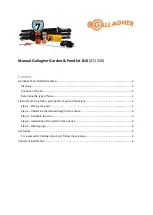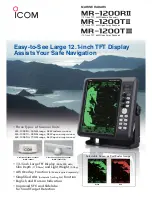
268
406388/F
Range
The
Range
parameter defines how “far” you want the TrawlEye to detect echoes.
The range is defined from a selected start range, and down to a value less than the
current bottom depth or a distance in horizontal direction in the water. A better
resolution is achieved using the shorter ranges.
With a trawl opening of 5–6 meters, you should select a 10m or 15m range value.
If you want to configure a PX TrawlEye sensor that is version 2.12 or higher, you
can select a dual range. With dual range, 50% of the echogram resolution is used
on the first 5, 10, 15 or 20 meters; the rest of the resolution is used on the rest of
the echogram: that is 95, 90, 85 or 80 meters.
Pulse Duration
The
Pulse Duration
setting specifies the current duration ("length") of the
transmitted pulse. The duration ("length") of your transmitted pulse is very
important to how you can detect fish. The pulse duration can be selected according
to the current range and what kind of targets you are looking at.
• A short pulse duration gives you a very fine vertical resolution.
• A long pulse duration throws a lot more energy into the water, and the digital
filters used by the receiver are narrower.
In shallow waters a short pulse duration is used and in deeper waters a longer
pulse duration is more useful.
The shorter pulses offer a higher resolution and a shorter blanking zone, but they
are more affected by noise. We recommend using short pulse length on low trawls,
in the tunnel and at the cod end.
The pulse lengths 512µ, 1024µs and 2018µs use FM sweep (Chirp) technology
and give high resolution even if the pulse length is long. However, the longest the
pulse, the largest the blanking zone. We recommend using 512µs (default value)
and longer pulses on trawls from 15m and more height
TVG
The purpose of the TVG compensation is to make targets of the same size produce
echoes of the same size, regardless of the range. Time Variable Gain (TVG) is
applied to the echo signals before they are displayed. The TV80 system can work
with several different TVG compensation settings. The default value is shown
with an asterisk.
Signals received from long ranges are amplified to compensate for losses due to
geometric spread and absorption. By means of algorithms, the time variable gain
compensation converts the echo presentation as a function of range. This makes
the targets with the same strength appear with the same intensity independent of
their physical distance from the transducer.
Simrad TV80 Reference Manual
Содержание Simrad TV80
Страница 1: ...kongsberg com simrad Simrad TV80 REFERENCE MANUAL ...
Страница 2: ......
Страница 353: ......
Страница 354: ... 2021 Kongsberg Maritime ...
Страница 355: ......
Страница 356: ...Reference Manual Simrad TV80 ...
















































